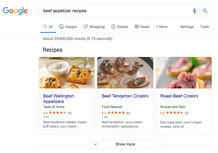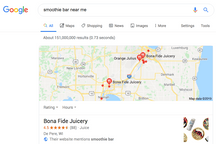This fall, a new study came out that shows organic search was responsible for 53% of all websites traffic. Over half is a lot. Imagine only having half of your morning cup of coffee. Or only getting half way to work on your daily commute to find out the other half of your train route is closed.
We like things whole, and we’re going to be proactive in 2020 about keeping and improving the valuable half of our clients’ website traffic from organic search.
Losing half of your website traffic would create a loss that’s hard to come back from. Organic search optimization is something all brands should consider to continue getting qualified traffic to their site.
Are you not getting that much organic search traffic to your site? Now’s the time to consider if it’s the chicken or the egg. Is your website not getting organic search traffic because your audience’s path to purchase doesn’t include search engines? Or are you not getting traffic from your key audiences because your website is not optimized? Consider this. Users across the world make 63,000 searches per second per day. So, an educated guess says your audience has used a search engine before.
While we all want to be found first in results, it takes a holistic ongoing effort. There are many components that go into a successful strategy for driving and maintaining this amount of traffic. Consider these tactics when crafting your SEO strategy for 2020.
- Featured Snippet
- Search beyond Google.com
- Mobile technology
- Accessibility for all searchers
- On-website engagement
- User information security
- Query context and search intent
- Gaps in search for content opportunities
- Building backlinks
Let’s start planning your 2020 SEO strategy.
1. Featured snippets and Google answers
Links, title tags, and page descriptions aren’t the only way to show up in search anymore. Take this search for example: “beef appetizer recipes.” Google has started indexing rich results, also known as snippets, as the first thing users see. It’s highly visual and easier to gather information to better decide which link to click.
Other recipe websites that aren’t marked up for the visual results typically display in the traditional link, title tag, and page description result. It is still great to have your website in the links results, but users are more engaged with the visual suggested recipes that Google sees as the authority.
How to incorporate this into your SEO strategy: Create quality content that is marked up with schema to help your site be part of the featured snippet.
2. Searches beyond Google.com
Google search is not only a search engine, it’s a verb. It’s the king in the search space, but it’s not the only place your audience is looking.
The Google Maps app is a tool used to find local businesses. Consider optimizing your Google Business location for the best maps app experience.
YouTube, a video platform that’s owned by Google, is a place users search for information in video format. Your brand’s video assets should be optimized and on YouTube as another space your audience can learn.
Amazon is the other big online player where nearly all audiences are looking for B2C products. Products, product reviews, and queries like “gifts for mom” are common on this platform. Your brand can perform in this search space with quality, optimized product listings.
How to incorporate this into your SEO strategy: Consider optimizing content on third party platforms beyond your website to be found where users are searching.
3. Mobile traffic and changing smartphone technology
Optimizing the user experience on mobile devices should be your priority. Changing technology that allows for crystal clear picture means your website needs to be not only responsive, but have quality imagery, too. Small screen size doesn’t mean you can get away with poor quality.
Test all beta sites and preview website design in mobile layout first because it’s likely that over half of your website’s traffic is made up of users on a mobile device.
How to incorporate this into your SEO strategy: Run a mobile test across your website to check for any instances of a poor experience. Adopt a mobile-first mentality when creating content when it comes to length of paragraphs, layout of pages, and accessibility.
4. User experience for all abilities
Accessibility for all users is not an option. As a brand, it’s important that your brick and mortar is completely accessible to all patrons. Your website should be the same way. Everything from the navigation to the color choice of buttons to the image alt text should be compliant with the Americans with Disabilities Act.
A bad experience is not only poor customer service, but it can flag your site as a negative user experience, which can have a bad impact on Google rankings if users are consistently bouncing or not finding what they need.
How to incorporate this into your SEO strategy: Run an audit to determine if your website is meeting the regulations and is in compliance with ADA.
5. On-site engagement tactics
On-site engagement is a positive ranking factor that can help indicate to Google that your website is a good resource for searchers. Signs of positive engagement are average time on site, pages per visit, completed actions like watching videos or submitting forms, and sharing links that create quality referral traffic.
To help get this kind of engagement on your website, you need to have quality content that users can engage with. Webinars help increase time on page. Chat bots can help suggest content based on user actions or help users who might be stuck. Interactive infographics can help drive longer session durations. On-site reviews can create engaging forms and readable content that is indexable.
How to incorporate this into your SEO strategy: Create quality content that your users will likely take the time to read, share, or interact with to generate on-site touchpoints.
6. User security
That annoying popup that shows a website uses cookies, or the privacy policy and terms of use that you never read, are all part of compliance that brands should not overlook. User privacy is not just becoming best practice, there are laws in place that require regulations to keep user data secure. Laws like GDPR and CCPA should be considered as part of your website’s optimization strategy to avoid issues.
Another key component of a secure user experience is having an HTTPS website, rather than HTTP. An SSL certificate ensures secure access to your website. Some browsers like Chrome even warn users before visiting a non-HTTPS website to deter non-secure connections. Don’t let a non-secure site prevent your site from getting traffic.
How to incorporate this into your SEO strategy: Review your website’s terms and policies with your legal team to ensure you’re compliant. Install an SSL certificate to have a secure, HTTPS website.
7. Query context and search intent
Google is learning every day. Now they are not only matching search queries to the keywords on a site, but the search engine is learning query context and search intent.
Query context is the deeper meaning or likely background around a search. For example, if someone searches different phrases back to back in a session, the two phrases are likely connected. If they first search “why my tap water smells” followed by a search “how to tell if you have bacteria in your water” it is likely that the person will be looking for solutions about how to treat problem water with filters in their home. Google can infer this based on the series of searches and suggest other queries or results based on solving the problem.
Search intent is the action a user is probably going to take based on the answers they find. For example, if someone searches “smoothie bars near me” the intent behind that search is that they are likely looking to visit a smoothie bar and purchase a smoothie. Google provides results as a map listing first, knowing that the users will need to navigate to the smoothie bar to purchase the desired smoothie.
How to incorporate this into your SEO strategy: Consider the context of your users’ searches and the intent behind them when optimizing your content. Don’t just stuff keywords of the products or services you provide, offer solutions-based content that actually answers questions or helps a user along their info-gathering path.
8. Gaps in topics
When looking for what to optimize, your research should include reviewing the content that already exists in search. There are some websites that are the authority on subjects and have years of built authority around a certain topic. One way to build authority without having to compete is by finding the gaps in topics. Is there high search volume around a topic your company specializes in, but no other website has easy-to-read content? Focus on high-volume searches with low competition and create content that will be a quality resource in a space that is lacking clear answers.
How to incorporate this into your SEO strategy: Take the time to research your products or services like a customer would. Search potential pain points and review the content that’s already in search to find gaps. These content gaps should be your focus for your 2020 SEO strategy.
9. Building backlinks
Backlinks to your website drive quality referral traffic from other websites. Search engines view quality backlinks on authority websites as a positive ranking factor. As part of your SEO strategy, think strategically about the best sites to have backlinks based on where your audience is engaging. Incorporating a strong public relations strategy could help you get placements on third-party media sites where your audience is reading articles or news. These backlinks help position your site as a subject matter expert with the right backlink anchor text.
Similarly, if there are online discussions about the products or services you offer, join the conversation and provide links to quality resources on your website. This tactic could take place on Reddit, Twitter chats, YouTube comments, Quora, and other online conversations. By including links to helpful content, qualified users will be more likely to click and engage with your website. This tactic helps reach people who aren’t necessarily searching in Google for answers, but are looking to trusted communities for answers.
How to incorporate this into your SEO strategy: Listen to key communities and join the conversation when it’s appropriate. Create optimized content that offers answers to questions, and promote it via backlinks across earned media or online discussions.
These tactics should get you started on an effective 2020 SEO strategy.
But remember, it takes time. Creating quality content with strong search authority can’t happen overnight. It starts with strategy and figuring out the best goals, strategy, and tactics for your brand.
Where ever you are in the 2020 planning process, our digital team is here to help. Whether you want to simply know if your website is ADA compliant, or you want our help writing quality content about smoothie bowls, we’ve got the experience and tools to help.










